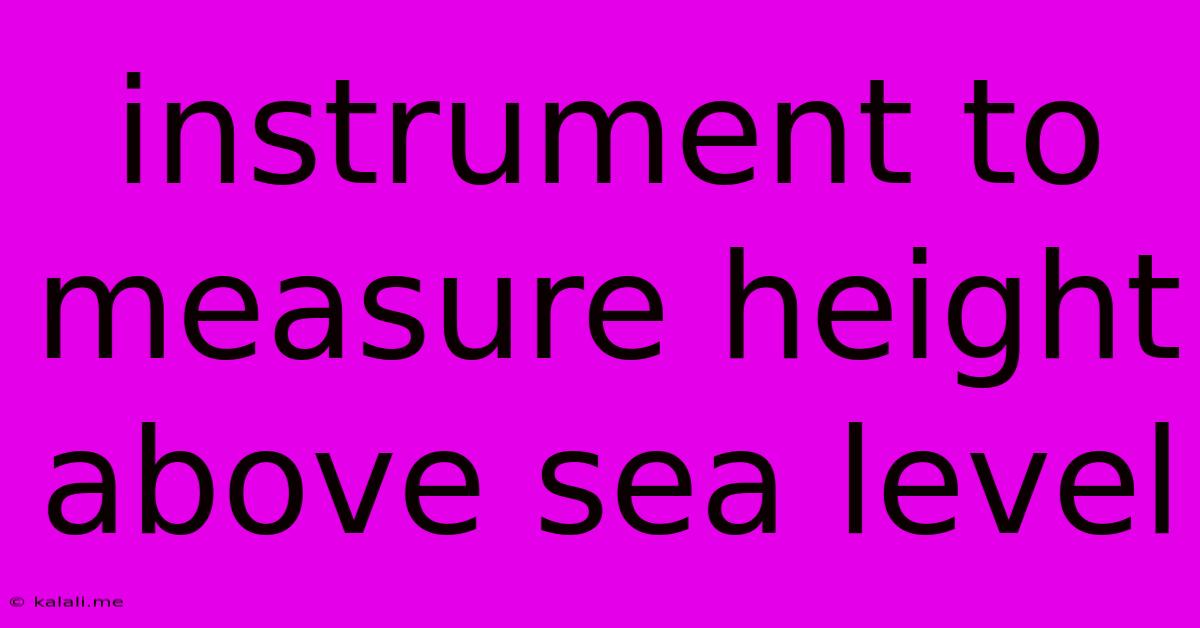Instrument To Measure Height Above Sea Level
Kalali
Jun 14, 2025 · 3 min read

Table of Contents
Instruments to Measure Height Above Sea Level: A Comprehensive Guide
Determining height above sea level, also known as elevation or altitude, is crucial in various fields, from surveying and mapping to aviation and meteorology. Several instruments are used to achieve accurate measurements, each with its own strengths and weaknesses. This article explores the key instruments and technologies employed for measuring height above sea level. Understanding these tools allows for a better appreciation of the data used in geographical information systems (GIS), topographic maps, and other applications relying on precise elevation information.
1. Traditional Surveying Techniques:
These methods, while sometimes less precise than modern technologies, remain relevant, especially in areas with limited access to advanced equipment.
-
Leveling: This classic surveying technique utilizes a leveling instrument (a theodolite or automatic level) and a leveling staff (a graduated rod) to determine differences in elevation between points. By establishing a series of interconnected benchmarks, the elevation of a point relative to a known datum (typically mean sea level) can be determined. This is a labor-intensive process but provides accurate results over relatively short distances.
-
Trigonometric Leveling: This method uses angles and distances to calculate elevation differences. A theodolite measures the vertical angle to a target, and the horizontal distance is measured, typically using electronic distance measurement (EDM) equipment. This method is often used in areas with challenging terrain where leveling might be impractical.
2. Modern Geospatial Technologies:
These sophisticated technologies provide highly accurate and efficient elevation data over large areas.
-
Global Navigation Satellite Systems (GNSS): GNSS, including GPS, GLONASS, Galileo, and BeiDou, are the workhorses of modern elevation measurement. Receivers measure the time it takes for signals from satellites to reach the receiver, calculating the precise position, including elevation, relative to a geodetic datum. The accuracy of GNSS measurements depends on various factors, including satellite geometry, atmospheric conditions, and the type of receiver used. Differential GNSS (DGPS) and Real-Time Kinematic (RTK) GNSS techniques improve accuracy significantly, enabling centimeter-level precision.
-
LiDAR (Light Detection and Ranging): LiDAR uses laser pulses to measure distances to the earth's surface. Mounted on aircraft or ground vehicles, LiDAR systems rapidly collect vast amounts of elevation data, creating highly detailed digital elevation models (DEMs). LiDAR is particularly useful for generating high-resolution topographic maps and identifying features like tree canopies and building heights.
-
Photogrammetry: This technique utilizes overlapping aerial or ground photographs to create 3D models of the terrain. Specialized software analyzes the images, extracting elevation information based on parallax – the apparent shift in an object's position when viewed from different angles. Advances in drone technology and image processing have made photogrammetry a cost-effective method for generating elevation data, especially for smaller areas.
3. Indirect Measurement Techniques:
Some methods infer elevation rather than directly measuring it.
- Barometric Altimeters: These instruments measure atmospheric pressure, which decreases with increasing altitude. Knowing the relationship between pressure and altitude allows for an estimation of elevation. However, barometric altimeters are sensitive to weather conditions and provide less accurate results than other methods. They are frequently used in aviation and hiking for relative elevation changes.
Choosing the Right Instrument:
The optimal instrument for measuring height above sea level depends on various factors, including:
-
Required accuracy: High-precision applications, such as surveying for construction, require GNSS or LiDAR. Less precise applications, like recreational hiking, might only need a barometric altimeter.
-
Area to be covered: Large areas benefit from LiDAR or GNSS, while smaller areas can be surveyed using traditional leveling or photogrammetry.
-
Budget and accessibility: Traditional methods and barometric altimeters are relatively inexpensive, while advanced technologies like LiDAR and RTK GNSS can be costly.
In conclusion, a range of sophisticated instruments and techniques exist for determining height above sea level. The selection of the appropriate method depends on the specific needs of the application, balancing accuracy, cost, and feasibility. Understanding these diverse approaches is key to appreciating the wealth of elevation data used to map and understand our planet.
Latest Posts
Latest Posts
-
Electric Current Is Defined As The Flow Of
Jun 14, 2025
-
Which Of The Following Is A Primary Pollutant
Jun 14, 2025
-
Difference Between A Physical Map And A Political Map
Jun 14, 2025
-
Definition Of Normal Profit In Economics
Jun 14, 2025
-
Is 23 A Multiple Of 3
Jun 14, 2025
Related Post
Thank you for visiting our website which covers about Instrument To Measure Height Above Sea Level . We hope the information provided has been useful to you. Feel free to contact us if you have any questions or need further assistance. See you next time and don't miss to bookmark.